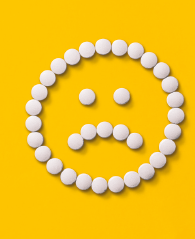How is ADHD managed and treated?
How can ADHD be managed?
 Getting ADHD diagnosed and treated is very important. Treatments focus on reducing symptoms and improving the ability to focus, learn and work. Although treatment will not ‘cure’ ADHD, it can help people with ADHD to deal with their condition more effectively.
Getting ADHD diagnosed and treated is very important. Treatments focus on reducing symptoms and improving the ability to focus, learn and work. Although treatment will not ‘cure’ ADHD, it can help people with ADHD to deal with their condition more effectively.
Because everyone with ADHD is different, they all need their own individual management plan, tailored to their own needs. There is a wide range of available options to support you on your journey.
It is important to recognise how adult ADHD may be impacting you in all aspects of your everyday life, so that you can work with your doctor to find a management strategy that works for you.
Depending on your individual needs and symptoms, your tailored management plan may involve psychological and educational therapies, medication, or combination treatment. Regular check-ups will determine what changes, if any, need to be made.
Your healthcare professional will work with you to find the right approach for you at every step. Different healthcare professionals will be available to support you along your journey, for example, the doctor, nurse or psychologist.
The more involved you are with the decisions made about your treatment, the more likely you’ll be happy with them. Remember, good healthcare professionals should make it clear and simple what’s happening.
 These tips may help when interacting with healthcare professionals
These tips may help when interacting with healthcare professionals
- Make a list. Get ready for your visit – write down a list of everything you’d like to talk about in your appointment. Important things can easily be forgotten once talking starts
- Make sure you understand. To make sure your doctor has explained him or herself clearly, try repeating back what he or she has said. This is sometimes known as ‘active listening.’ Writing everything down is also a good idea
- Bring a friend. Having someone else there to take notes, ask questions or just be supportive can really help
- Medication. If your doctor prescribes medication, make sure you take it as directed
- Don’t be afraid to ask questions if you don’t understand something
What are the goals of treatment?
 It’s a good idea to set one or more treatment goals with your healthcare professional. Think about what you would like to achieve and discuss it with your family, friends or colleagues. These goals could be as big or as little as you want, for the short or the long term, but try not to set expectations too high to start with.
It’s a good idea to set one or more treatment goals with your healthcare professional. Think about what you would like to achieve and discuss it with your family, friends or colleagues. These goals could be as big or as little as you want, for the short or the long term, but try not to set expectations too high to start with.
- The first goal should be easily achievable within a short time frame
- You can reassess goals from time to time and make them more ambitious as time goes by
- Don’t worry if you have a bad day – just try again the next day
What are psychological and educational therapies?
Some psychological and educational therapies are effective in some people with ADHD. For other people, they will be used along with medication, as part of a comprehensive treatment plan.
- Behavioural therapy: These talking therapies are about learning to manage your problems by changing the way you think and behave. For example, cognitive behavioural therapy
- Psychoeducation: Educating you, your family and/or carers to help them understand about ADHD. This may be on an individual basis or in group sessions
What about medication for ADHD?
You may decide with your doctor to take medication for your ADHD.
There are two main types of medication available:
- stimulants
- non-stimulants
Both types of medication alter the communication of messages between nerve cells, reducing the symptoms associated with ADHD. Some people may respond to or tolerate only one medication, whereas others may respond to or tolerate more than one.
Which type of medication may be suitable for me?
 Each ADHD medication is available in different doses. Some also offer different formulations to choose from, including short-acting (lasting a few hours) and long-acting (lasting most of the day).
Each ADHD medication is available in different doses. Some also offer different formulations to choose from, including short-acting (lasting a few hours) and long-acting (lasting most of the day).
Non-stimulants work in a different way to stimulants – they may take longer to work but have a longer duration of action.
In order to best meet your individual needs, it may take a little while to work out which is the best medication, dose and formulation for you. Your healthcare professional will re-assess your treatment regularly and make adjustments, if necessary, to provide you with the treatment that works best for you.
What about side effects?
Like all medicines, your ADHD treatment may cause side effects although not everybody gets them. Different side effects can occur with the different types of medication.
 Your healthcare professional will talk to you about which side effects may occur with your treatment. They will review your treatment regularly and check your weight, heart rate and blood pressure before and during treatment. If you are concerned about any of the effects of your treatment, including side effects, please talk to your healthcare professional.
Your healthcare professional will talk to you about which side effects may occur with your treatment. They will review your treatment regularly and check your weight, heart rate and blood pressure before and during treatment. If you are concerned about any of the effects of your treatment, including side effects, please talk to your healthcare professional.
Reporting of side effects: If you get any side effects, talk to your doctor, pharmacist or nurse. This includes any possible side effects not listed in the package leaflet. You can also report side effects directly via the Yellow Card Scheme at: www.mhra.gov.uk/yellowcard or search for MHRA Yellow Card in the Google Play or Apple App Store. By reporting side effects you can help provide more information on the safety of this medicine.
Sometimes side effects get better once you have settled on the medicine or you may learn to manage them. If side effects are bothering you, your doctor may adjust the dose of the medicine or it may be necessary to change to a different medicine. You should not stop taking your medicine without first talking to your doctor.
What about work or college?
At work or college, talk to your employer or tutor about ‘reasonable adjustments’. Employers and education providers have legal obligations to make sure that workers or students with disabilities or physical or mental health conditions are not substantially disadvantaged when doing their jobs or during their education.
 Environmental modifications are changes that are made to the physical environment in order to minimise the impact of a person’s ADHD on their day-to-day life. Appropriate environmental modifications will be specific to the circumstances of each person with ADHD and should be determined from an assessment of their needs.
Environmental modifications are changes that are made to the physical environment in order to minimise the impact of a person’s ADHD on their day-to-day life. Appropriate environmental modifications will be specific to the circumstances of each person with ADHD and should be determined from an assessment of their needs.
Examples may include:
- changes to seating arrangements
- changes to lighting and noise
- reducing distractions (for example, using headphones)
- optimising work or education to have shorter periods of focus with movement breaks
- reinforcing verbal requests with written instructions
Useful Links
Patient support organisations
- ADHD Foundation – Adults – https://adhdfoundation.org.uk/
- ADHD Solutions – https://www.adhdsolutions.org/
- The National Attention Deficit Information and Support Service (ADDISS) – https://www.addiss.co.uk
- Scottish ADHD coalition – https://www.scottishadhdcoalition.org
Professional organisations
- UK Adult ADHD Network (UKAAN) – https://www.ukaan.org
- National Health Service – Overview ADHD – https://www.nhs.uk/conditions/attention-deficit-hyperactivity-disorder-adhd/
- Royal College of Psychiatrists – ADHD in adults – https://www.rcpsych.ac.uk/mental-health/problems-disorders/adhd-in-adults
- National Institute for Health and Care Excellence (NICE) guideline NG87 – Information for the public – https://www.nice.org.uk/guidance/ng87/informationforpublic
You are now leaving www.adhdandyou.co.uk. You will be re-directed to an external website. Takeda accepts no responsibilty for the content of other websites.